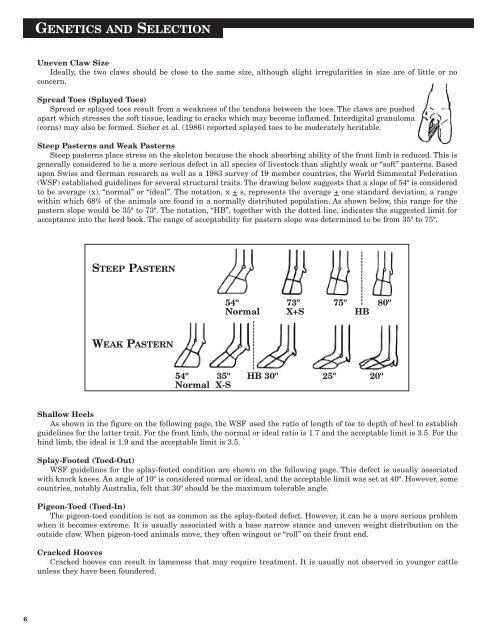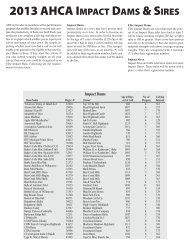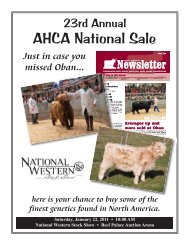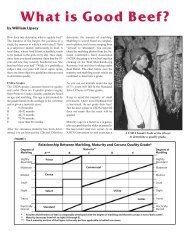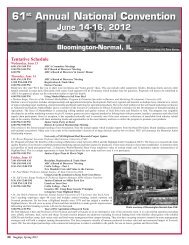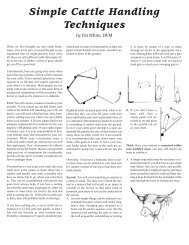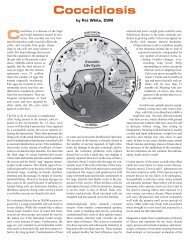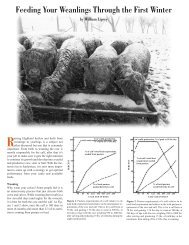The Bagpipe - American Highland Cattle Association
The Bagpipe - American Highland Cattle Association
The Bagpipe - American Highland Cattle Association
Create successful ePaper yourself
Turn your PDF publications into a flip-book with our unique Google optimized e-Paper software.
6<br />
GENETICS AND SELECTION<br />
Uneven Claw Size<br />
Ideally, the two claws should be close to the same size, although slight irregularities in size are of little or no<br />
concern.<br />
Spread Toes (Splayed Toes)<br />
Spread or splayed toes result from a weakness of the tendons between the toes. <strong>The</strong> claws are pushed<br />
apart which stresses the soft tissue, leading to cracks which may become inflamed. Interdigital granuloma<br />
(corns) may also be formed. Sieber et al. (1986) reported splayed toes to be moderately heritable.<br />
Steep Pasterns and Weak Pasterns<br />
Steep pasterns place stress on the skeleton because the shock absorbing ability of the front limb is reduced. This is<br />
generally considered to be a more serious defect in all species of livestock than slightly weak or “soft” pasterns. Based<br />
upon Swiss and German research as well as a 1983 survey of 19 member countries, the World Simmental Federation<br />
(WSF) established guidelines for several structural traits. <strong>The</strong> drawing below suggests that a slope of 54º is considered<br />
to be average (x), “normal” or “ideal”. <strong>The</strong> notation, x + s, represents the average + one standard deviation, a range<br />
within which 68% of the animals are found in a normally distributed population. As shown below, this range for the<br />
pastern slope would be 35º to 73º. <strong>The</strong> notation, “HB”, together with the dotted line, indicates the suggested limit for<br />
acceptance into the herd book. <strong>The</strong> range of acceptability for pastern slope was determined to be from 35º to 75º.<br />
STEEP PASTERN<br />
WEAK PASTERN<br />
54º 73º 75º 80º<br />
Normal X+S HB<br />
54º 35º HB 30º 25º 20º<br />
Normal X-S<br />
Shallow Heels<br />
As shown in the figure on the following page, the WSF used the ratio of length of toe to depth of heel to establish<br />
guidelines for the latter trait. For the front limb, the normal or ideal ratio is 1.7 and the acceptable limit is 3.5. For the<br />
hind limb, the ideal is 1.9 and the acceptable limit is 3.5.<br />
Splay-Footed (Toed-Out)<br />
WSF guidelines for the splay-footed condition are shown on the following page. This defect is usually associated<br />
with knock knees. An angle of 10º is considered normal or ideal, and the acceptable limit was set at 40º. However, some<br />
countries, notably Australia, felt that 30º should be the maximum tolerable angle.<br />
Pigeon-Toed (Toed-In)<br />
<strong>The</strong> pigeon-toed condition is not as common as the splay-footed defect. However, it can be a more serious problem<br />
when it becomes extreme. It is usually associated with a base narrow stance and uneven weight distribution on the<br />
outside claw. When pigeon-toed animals move, they often wingout or “roll” on their front end.<br />
Cracked Hooves<br />
Cracked hooves can result in lameness that may require treatment. It is usually not observed in younger cattle<br />
unless they have been foundered.


